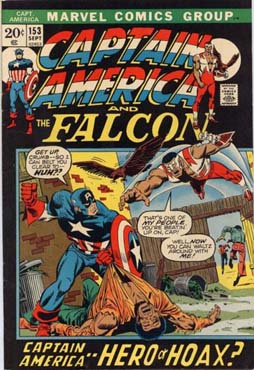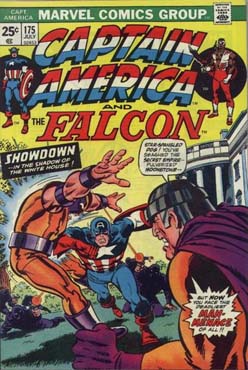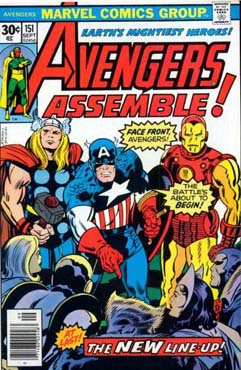|
|
 |
Despite being one of Marvel’s A-list characters, sales of the Captain America title were failing. Various writers with greater experience had tried to resuscitate the book without success. Editor-in-chief Roy Thomas turned to relative newcomer Englehart, telling him the book may very well be canceled, or at least go bi-monthly, if sales didn’t improve.
Englehart took over writing with Captain America #153 (September 1972) believing the character should reflect American ideals, rather than the short-term zeitgeist of the US government. The country was exiting the war in Vietnam and the Watergate scandal was breaking news. Englehart pondered the idea of how Captain America would react to the America of 1974, leading to his Secret Empire storyline as an analogue to Watergate.
The Secret
Empire storyline concluded in Captain
America #175,
which went on sale in April 1974, just a few months before
Richard Nixon’s resignation on August 9. “When it was coming to an end,”
explains Englehart, “it was clear that Nixon was going to be gotten, but he
hadn’t been gotten yet. So Secret Empire had a character with access to the
Oval Office, and the idea that the president was a crook was a major concept in
those days.”

Englehart surmised that like many Americans, Captain America would become disillusioned by an America he no longer recognized. “As I followed this guy’s personality, I figured he would say, ‘I gotta be a hero, but I can’t do it wearing the red, white and blue anymore.’ So that’s how Nomad came to be, as an alternative identity for Steve Rogers.”
When Englehart has inherited a pre-existing character from someone else, he starts with how they exist in that moment. “Getting them to where I want them to be, well, that’s a story line,” he says. “It’s not ‘I’m here now, everything is different.’”
Englehart’s success with Captain America led to him being tapped for the Avengers, a book he wrote for four years, breathing new life into the team and fresh characterization into each of its members. However, after Roy Thomas stepped down as editor-in-chief, the position was passed around among various personnel for several years, including Marv Wolfman, Archie Goodwin and Gerry Conway. According to Englehart, the editor du jour – whom he declines to identify by name – pulled him off the book.
“He decided
to take the Avengers away from me, and the Defenders away from Steve Gerber,
because he wanted to write them himself,”
says Englehart. “That was not in the spirit of the Marvel Comics I’d come to
admire, so I figured I’d quit comics and go do something else.”

Englehart's final issue of the Avengers
Whatever that something else may have been never happened, as DC Comics editor-in-chief Jenette Kahn asked him to take over writing the Justice League of America. “She said specifically, ‘I want you to do for the Justice League what you did for the Avengers,’” Englehart says.
Next Week: The DC Years
© Copyright 2002-2025 by Toon Doctor Inc. - All rights Reserved. All other texts, images, characters and trademarks are copyright their respective owners. Use of material in this document (including reproduction, modification, distribution, electronic transmission or republication) without prior written permission is strictly prohibited.

